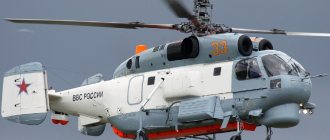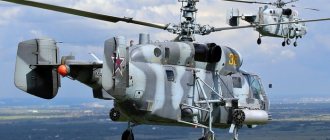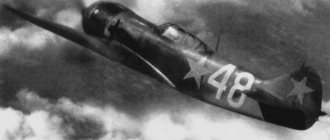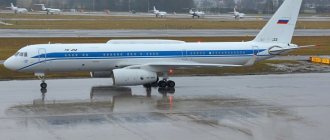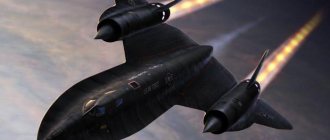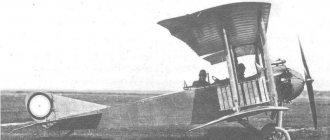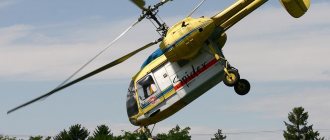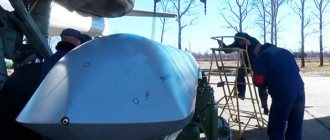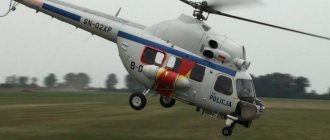"Child of the Thaw"
Among the measures contributing to this, the comprehensive development of transport, including civil aviation, was named. At the same time, defense spending was reduced, and the freed-up funds were planned to be used again to improve the people's well-being. A “thaw” began within the country, and detente began in the world as a whole.
The main Soviet army helicopter of the 50s was the piston Mi-4. It was to be replaced by the gas turbine Mi-8 Photo: Moscow Helicopter Plant named after. M.L. mile
During this period, the creation of the first generation of aircraft with jet and turboprop engines, as well as the Mi-6 heavy helicopter, was successfully completed. Its creator M.L. Mil also proposed a project for a new medium helicopter B-8.
It was originally created as a version of the Mi-6 reduced to the size of the Mi-4 with two gas turbine engines. The project was supported by the Central Committee of the CPSU, but the State Planning Committee could not understand that the increase in the cost of development, production and operation of a helicopter compared to an aircraft of the same payload by 1.5...2 times is an objective reality, and not mismanagement on the ground, and this In the department, the helicopter industry turned out to have staunch opponents. Aeroflot became interested in the new helicopter, and on February 20, 1958, a resolution of the Council of Ministers determined an order for the B-8. But to please the “guys from Gosplan,” the OKB agreed to make it not as a new machine, but as a modification of the Mi-4 under one AI-24V gas turbine engine, a modification of the “aircraft” engine designed by Ivchenko. M.L. himself continued to play the main role in the engineering development of the machine. Mil, but for the B-8 other responsible managers were appointed in the OKB structure: Chief Designer V.A. Kuznetsov and presenter - G.V. Remezov.
Already during the pre-design study, in agreement with the Customer (and since 1959, there were already two departments for the B-8 - Aeroflot and the Air Force), it was decided to increase the size of the helicopter while maintaining a payload capacity of 2 tons, as well as to simultaneously design a number of modifications of the B-8. A passenger version, civil and military transport, army armed and naval anti-submarine helicopters were created. Today we will focus on options for army aviation.
An experimental Mi-8 helicopter with one AI-24V gas turbine engine in a demonstration flight
The V-8 moved further and further from its “prototype” Mi-4 both in the layout and in the “little things”: it used “blown” transparent glazing panels, adhesive-welded joints, and large-sized stampings. In the control system, the hydraulic boosters were interlocked with other hydraulic units into a compact “hydraulic combine” and hung directly on the main gearbox. Hydraulic dampers were installed in the vertical hinges of the main rotor instead of friction dampers, and trimmers were installed on the blades. Instead of two front supports, they made one, etc.
That same year, production of five prototype B-8s began. The OKB's own production base, exhausted by relocations, was still weak (the Milevians had been at plant No. 329 for more than five years, but had not yet had time to acquire everything they needed). The main units were made by Plant No. 23, where OKB-329 had a representative office and the Mi-6 was mass-produced. The first prototype was assembled by Plant 329. It was delivered in a passenger version with an 18-seat luxury cabin and in a modest but beautiful coloring, however, without a civil registration number and the “Aeroflot” inscription. The first flight on it was made by a factory crew under the command of B.V. Zemskova June 24, 1961.
Installing two engines instead of one opened the way to improving flight performance and increasing the reliability of the Mi-8 Photo: O. Yakubovsky
The G8 not only quickly and successfully passed the factory testing stage, but also immediately “liked” the top party leadership. Mil attached paramount importance to demonstrations of the vehicle, and after a couple of weeks the B-8 participated in the Tushino air parade, and then was exhibited with great success at VDNKh, where it was immediately noticed by the foreign press.
At the end of 1961, the V-8 was transferred to State tests, but Mil already knew that the single-engine vehicle would not go any further.
New name and big series
Mikhail Leontyevich’s perseverance and a well-chosen initial decision led to an outstanding result. In just three years, the designers managed to make a new aircraft instead of the Mi-4 modernization announced at the beginning. With the launch of the series, the helicopter became officially known as the Mi-8. The production of the machines was launched at the Kazan Helicopter Plant. At the end of 1965, the first production cars rolled off the assembly line.
In June 1965, the Mi-8 was presented at the Paris Air Show and received high marks from foreign experts. In general, much attention was paid to the promotion of the helicopter abroad. During one of the “advertising” flights around the world, test pilot German Alferov flew a total of 35 thousand km on the Mi-8, that is, he practically flew around the globe.
The demand for the Mi-8 was so great that it was necessary to launch a second serial production in Ulan-Ude. In civilian life they quickly appreciated the advantages of the new machine, but the military was in no hurry to replace the proven Mi-4 with a new helicopter. However, the participation of Soviet technology in the Vietnam War showed that the era of piston helicopters was a thing of the past. In 1968, the combat modification of the Mi-8 was adopted. Only after this important step were the helicopter developers awarded state prizes.
The first decision is the most correct one
Taking advantage of Khrushchev's interest in helicopters, Mil convinced both customers and the State Planning Committee of the need for two engines. This was no longer a modification of the Mi-4, but a completely new product, expensive but effective. Khrushchev, having visited the USA, saw “their” government helicopters and was inspired by the idea of such a machine, and one engine did not provide sufficient reliability - and on May 30, 1960, a decree was issued on the B-8A helicopter with two light and economical gas turbine engines of 1250 hp each. . development of the Leningrad KB-117 S.P. Izotov. At first, a competitive development was planned, but, oddly enough, there were no more people willing to take on this order. The same team also made the new gearbox. During the design, while maintaining the specified weight of 300 kg and length of 3 m, it was possible to increase the power to 1500 hp. on takeoff. This guaranteed landing at a remote site at any flight weight on one engine.
The B-8A helicopter with two gas turbine engines entered testing in a passenger version. The first hover on it was carried out on August 2, 1962. In March 1963, the vehicle was transferred to State tests, in which both civilian pilots and military personnel from the Air Force Research Institute took part.
Serial army transport helicopter Mi-8T of the first series without weapons Photo: O. Yakubovsky
Despite the overall success of the tests, various modifications, sometimes quite serious, were constantly made to the helicopter’s design.
Firstly, a “quiet” five-blade main rotor with a reduced vibration level appeared. We resolved the issue of synchronizing the rotation of motor shafts and stabilizing the NV frequency within specified limits. An emergency mode was introduced to briefly increase the power of one engine when the second one failed. The AP-34 autopilot was unified with the Mi-4 and Mi-6. The vibration of the helicopter at the moment of takeoff and touch (“ground resonance”) was eliminated by installing two-chamber liquid-gas landing gear shock struts instead of primitive single-chamber ones. The wheels of the main supports are enclosed in fairings. True, the “bast shoes” were not in demand in the series. Soon the B-8A was transferred for endurance testing, and then again for flight testing, but in 1966 the car died in a crash due to the destruction of the tail rotor hub.
In the summer of 1963, the third vehicle, the V-8AT, entered testing. This was the first helicopter for the Air Force. Behind the large rectangular windows of the passenger version there was a cabin for 20...24 paratroopers, and in the bow there was a nest for an A-12.7 machine gun, which was empty for now. “Car” doors were replaced with sliding ones, which was later adopted for the civilian version. The rest of the car was similar to the B-8A. After short factory tests, the V-8AT passed into the hands of the military.
The experimental V-8AP No. 4 was supplied with a government cabin, which contained chairs for the “main passenger” and assistant assistant, separated by a mahogany table from the “guest” chair, as well as armchairs and a side sofa for accompanying persons. The car had new communication and household equipment. It was on the V-8AP that stage “B” of State Tests began in September: confirmation of the declared characteristics by the Customer’s testers. A month later, the same process began on the third machine. In the spring of 1965, the V-8AP was once again radically redesigned. A regular passenger cabin with 28 seats was installed on it. This arrangement later became the basis for the serial version for the MGA.
The fifth experimental helicopter became the standard for the series. In 1965, a positive conclusion based on the results of State tests was issued for the passenger, and then for the transport and landing versions.
Prerequisites for the creation of the MI 8 helicopter
After the end of World War II, the era of aviation and missiles began in the world. These technical means, due to their high speed, have made it possible to significantly reduce vast distances, making our world smaller and more accessible. Aircraft could operate more in a linear plane, covering long distances, providing rapid delivery of cargo, weapons and transportation of passengers. Helicopters, which had unique flight qualities, were assigned the role of a vehicle for targeted servicing of human needs.
First helicopter
The first helicopters and gyroplanes, designed before the war and during the war, were created on the initiative of the military. It was the military who saw unique flight qualities in the design of these aircraft. Rotorcraft could take off and land in a limited area and hover in the air. In tactical terms, such aircraft became a real boon for the military, capable of increasing the military potential of the armed forces. However, the lack of a clear understanding of the scope of application of rotorcraft, the features of their design and construction experience significantly hampered the development of this area of aviation.
Only with the end of the Second World War, which gave impetus to the rapid development of new technologies, did the necessary technological conditions appear to create more powerful and reliable aircraft of this class. Almost simultaneously, prototypes of rotorcraft began to appear in the USA and the USSR, in England and France. In those days, the main customers of design bureaus were the military. The same situation arose in the Soviet Union, where after the war a powerful aviation design school was formed. The country's top leadership relied on new types and means of weapons. In parallel with the creation of new aircraft, the development and creation of helicopter technology was underway. The greatest successes and progress in this area were achieved by the design bureau of Mikhail Leontievich Mil, created on a trial basis on the basis of aircraft plant No. 383.
M.L. miles
Already in September 1948, the first prototype of the machine took off, which a year and a half later was put into production. The Mi-1 helicopter marked the birth of a whole family of Soviet helicopters, one of which was the MI 8 rotorcraft.

